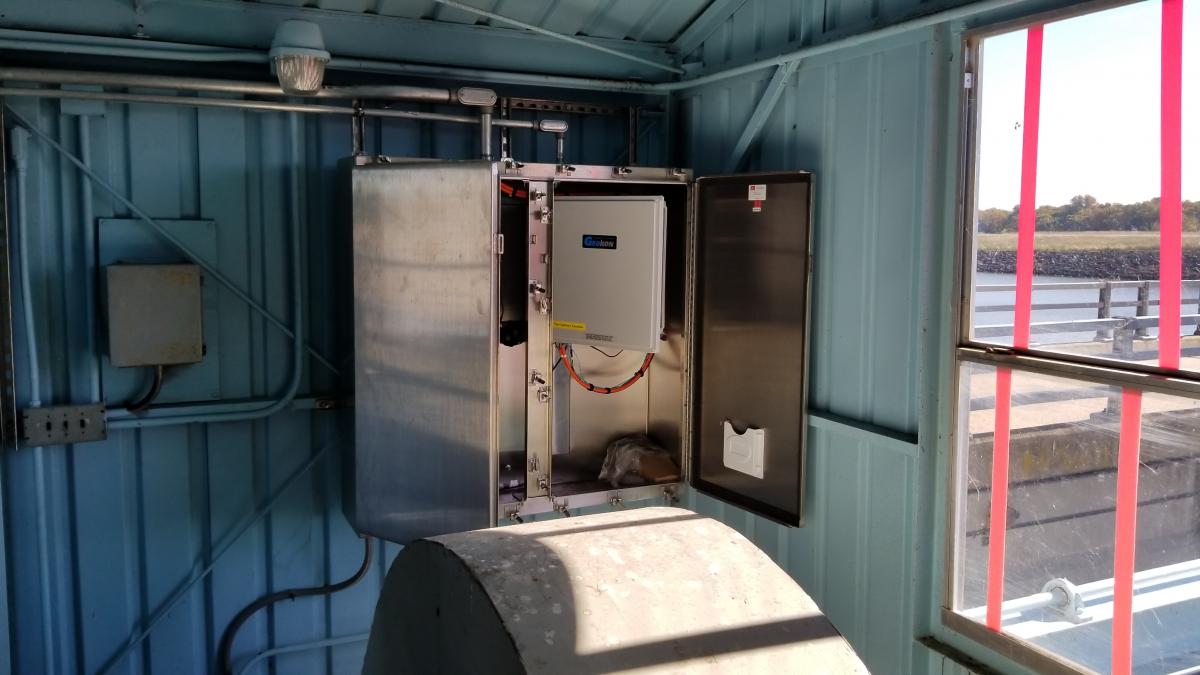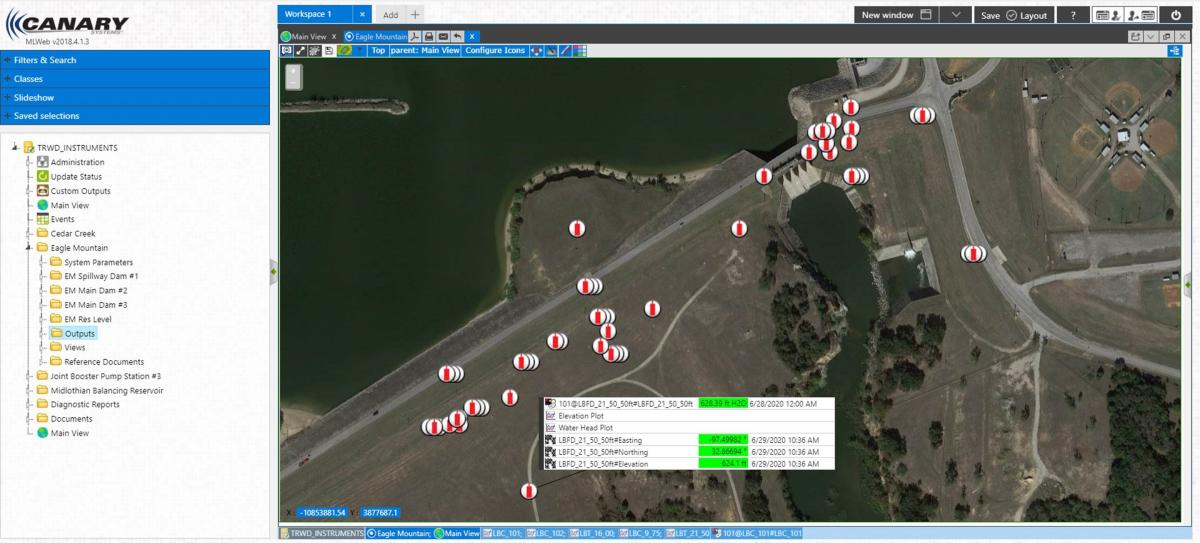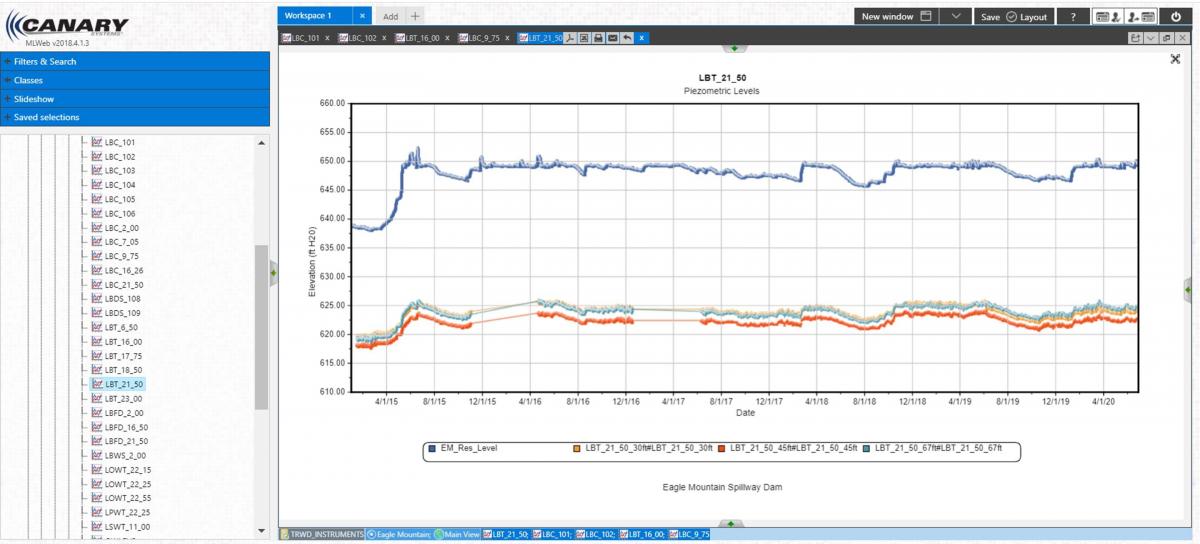Keep Aging Dams Up to Snuff: Leveraging Innovative Tools and Applications to Monitor and Sustain Four Large Texas Reservoirs
Dams are fundamental to water storage in Texas, and their safety and reliable performance are critical aspects to the water supply chain. The Tarrant Regional Water District (TRWD) is one of the oldest, largest, and most active water districts in Texas. TRWD owns and operates Lake Bridgeport, Eagle Mountain Lake, Cedar Creek Reservoir and Richland-Chambers Reservoir. These dams are integral components of a system that supplies water to millions of Texans, while also balancing flood flows with environmental demands. As part of a best-practices approach, TRWD has proactively implemented a variety of maintenance and rehabilitation efforts to protect the dams’ serviceability and the public.
Freese and Nichols has a long-standing relationship with TRWD dating to its establishment in the 1920s. We served as the lead designer of these dams and have been actively involved in their maintenance and rehabilitation during their service. We have worked hand-in-hand with TRWD to develop and execute various innovative techniques and approaches to keep these aging dams operational and safe. Some these innovative rehabilitation techniques have included:
 The design and construction of a large relief well network at Cedar Creek Reservoir to control dam under-seepage and improve overall stability. To ensure safety during the installation of the well networks, sonic techniques were used. The well networks were also designed to facilitate maintenance in flood-prone areas and include robust stainless-steel screens and risers that are resistant to damage from cleaning and corrosion. In addition, pump houses were also constructed to collect and return any of the under-seepage to the water supply reservoirs.
The design and construction of a large relief well network at Cedar Creek Reservoir to control dam under-seepage and improve overall stability. To ensure safety during the installation of the well networks, sonic techniques were used. The well networks were also designed to facilitate maintenance in flood-prone areas and include robust stainless-steel screens and risers that are resistant to damage from cleaning and corrosion. In addition, pump houses were also constructed to collect and return any of the under-seepage to the water supply reservoirs.- The design and future installation of a cutter soil mixer (CSM) cutoff wall at the Eagle Mountain Lake to address under seepage through the bedrock between the two primary spillway structures. This project included the innovative use of angled instrumentation that was installed using sonic drilling techniques. This allowed the placement of instruments in locations that were otherwise inaccessible and allowed for the convenient centralization of the cabling bundle and cable routing.

- The design and construction of an inverted filter system to address a persistent boil and internal erosion within a channel between the dam at Richland-Chambers Reservoir and the George Shannon Wetlands network. The filter includes an overlying articulated concrete block lining to match the approach to a low-head channel dam, maintain the integrity of the filter system, and to improve safety due to publicly accessibility of the area.
- The design and construction of a vertical drain and collection vault to efficiently address seepage around the soil cutoff on the left abutment of the dam at Cedar Creek Reservoir. Collection piping directs the seepage to a multi-chamber vault that includes v-notch weirs and water level instrumentation that allow for both visual and remote monitoring of flows.
 Complementing these dam rehabilitation efforts, another best practice is monitoring to confirm performance of these structures. TRWD has been ahead of the industry with the development of an automated data acquisition system (ADAS) for real-time monitoring of these instruments. This includes the installation of extensive cabling networks for the transmission of data, the use of robust instrumentation data collection panels and sheds, various measures for lightning and transient voltage mitigation, and a centralized database to record and monitor the readings. TRWD programmed their own software interface to manage the data and has since transitioned to an “off the shelf” interface after the state of instrumentation industry evolved to suit their needs. The interface allows for the convenient navigation of instruments through a GIS-based module and allows for view of historic trends at specific instruments and sectional views of multiple instruments at selected embankment locations.
Complementing these dam rehabilitation efforts, another best practice is monitoring to confirm performance of these structures. TRWD has been ahead of the industry with the development of an automated data acquisition system (ADAS) for real-time monitoring of these instruments. This includes the installation of extensive cabling networks for the transmission of data, the use of robust instrumentation data collection panels and sheds, various measures for lightning and transient voltage mitigation, and a centralized database to record and monitor the readings. TRWD programmed their own software interface to manage the data and has since transitioned to an “off the shelf” interface after the state of instrumentation industry evolved to suit their needs. The interface allows for the convenient navigation of instruments through a GIS-based module and allows for view of historic trends at specific instruments and sectional views of multiple instruments at selected embankment locations.

Freese and Nichols has been a key partner during the development of the instrumentation networks, including the design and construction of the network at Cedar Creek Reservoir, the design and installation of a new sub-network for the Eagle Mountain Lake Service Spillway, and early planning and design efforts for the network planned at Richland-Chambers Reservoir. These systems have included vibrating wire transducer (VWT) piezometers, VWT water level indicators for vaults, VWT water level indicators for open riser piezometers, barometers, and weather stations as well as SCADA components for float cut-off switches and pump station controls.
The database interface also includes an emergency notification system that helps improve overall dam safety and emergency response. TRWD currently uses threshold levels to trigger system alerts. Freese and Nichols has consulted with TRWD to develop protocols and methods for use in establishing the threshold levels but is also working with TRWD to pursue the use of industry leading algorithms to reduce false alarms and allow for more nuanced data monitoring and interpretation.
Because of the implementation of these innovative approaches and techniques, the aging assets continue to safely serve their surrounding communities at peak performance while being progressive. These aspects also allow the TRWD and their operators and workers to make the best-informed decisions through the high-quality information they receive from the networks, database and monitoring systems that were installed.

